Leopard Gecko Toes Grow Back Leopard Gecko Baby Substrate
The Leopard Gecko is a beautifully unique reptile that is famous for their striking leopard-like appearance and huge fat-storage tail.
Geckos are cute, docile and friendly picayune lizards with many interesting behaviors and endearing vocalizations.
They very apace adjust to being handled and are easy-to-care for whatever showtime-time owner!
Known scientifically every bit the Eublepharis macularius this species rattle their tail when threatened, mating, or during hunting.
Want to larn more near the leopard gecko? Proceed reading…
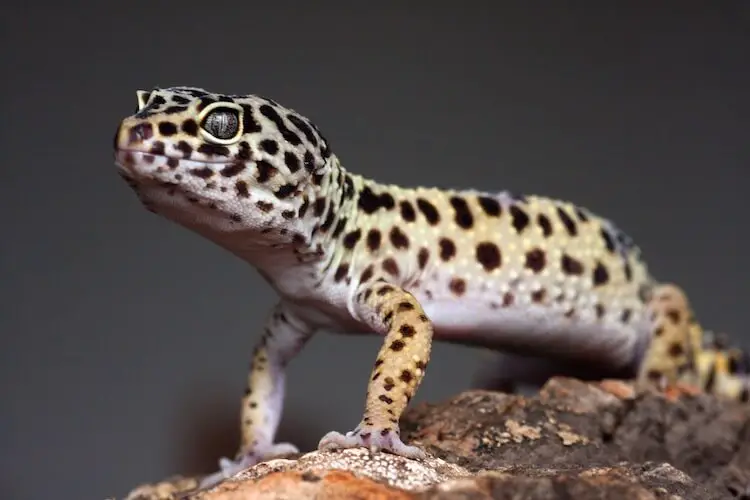
Table of Contents
- What Is A Leopard Gecko?
- Native Habitat
- What Nosotros Like Almost Leopard Geckos
- Species Appearance
- Colors
- How Big Do Leopard Geckos Get?
- Leopard Gecko Care Sheet
- Leopard Gecko Diet and Feeding Guide
- How Long Do Leopard Geckos Alive For?
- Leopard Gecko Habitat and Cage
- Typical Beliefs
- Leopard Gecko Baby
- How Much Does A Leopard Gecko Cost?
- Care Guide Summary
What Is A Leopard Gecko?
Native Habitat
The Eublepharis macularius is a lizard from the semi-dry to barren deserts and forest edges of a stretch of habitat ranging from Northwest India through to Pakistan, Islamic republic of iran, Iraq, and Afghanistan. They typically alive on the rocks of their desert scrub habitats.
Leopard Geckos have struck the hearts of many with their unique appearance, and are known by several different common names:
- Panther geckos
- Desert fat-tailed geckos
- Spotted fatty-tailed geckos
- Fat-tailed geckos
They are shy lizards that have fantastic predator-evading abilities and are inconspicuous with their leopard print in the dry out-desert rocks or tall grasslands.
These species are able to remain hidden for long periods of time because of their fat-storing tails that can sustain them until whatever threat they are facing is removed.
They also shed more than frequently than virtually lizards in social club to continue their scent from existence detected by predators.
Finally, the Leopard Gecko vocalizes very loudly. He will vocalize during mating, self-defense, or when excited by either chirping, barking, or making a hissing sound.
What Nosotros Like About Leopard Geckos
Pros
- Their docile beliefs makes them corking for beginners.
- They only demand a very small tank.
- It is easy for them to be housed in groups.
Cons
- They will drop their tail (i.due east. autotomy) when threatened.
- This species is very temperature-sensitive.
- They are nocturnal.
Species Appearance
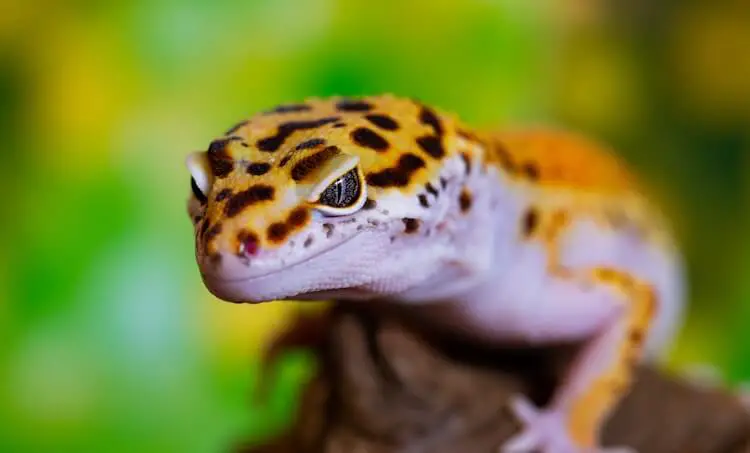
All Leopard Geckos take a small triangular-shaped head (similar to a crested gecko), a long trunk, and a chunky, segmented tail. They also have and slender digits with long, extending claws, and are ventrally white throughout.
Interestingly, none of their digits have toe pads, so they cannot attach to walls to climb similar other gecko species can.
Leopard gecko'south eyes typically have slit pupils. However, in that location many many mutations which are deliberately bred in captivity for:
- The "eclipse" mutation, which is completely filled in solid blackness or red color
- There is besides a mutation called "snake-optics" that accept partial leaks of the student into the iris
- The final mutation is "marble-eye," where at that place is spotting within the eye'southward iris
Typically leopard geckos take skin with a wart-like texture.
Some people breed morphs to remove those bumps, leaving smooth skin, known every bit scaleless. There are many unlike morphs, with varying patterns, eye colors, size, and fifty-fifty texture.
Colors
This lizard can be yellow, tangerine, lavender, or white with blackness or chocolate spotting, patching or striping. There are besides albino and melanistic occurrences.
Leopard Geckos have many varying patterns.
- Some have rosettes, concatenation-rosettes, or solid spotting.
- Some take stripes and patches that tin present with irregular blotching.
At that place are some hypomelanistic morphs that have spotting only on their head and tail.
How Big Practise Leopard Geckos Get?
Males are larger than females measuring between 7 to 11 inches and weighing 70-100 grams. Females are betwixt half-dozen.v to 8 inches and counterbalance between 40-ninety grams.
There is a morph chosen the Super Giant that tin can exist 12 inches long and weigh 175 grams.
Leopard Gecko Intendance Sheet
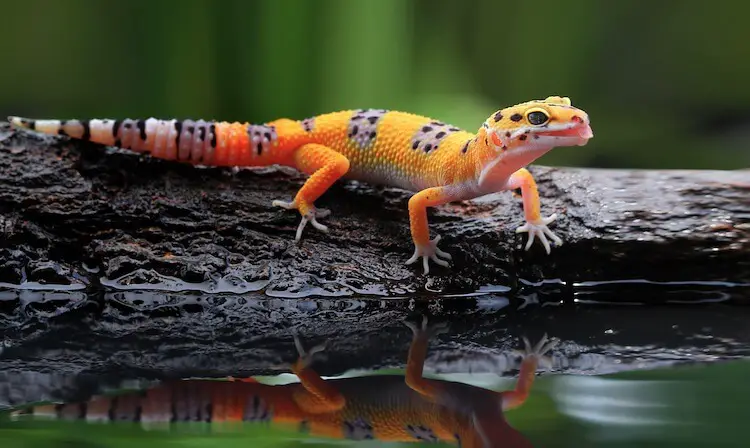
Leopard Gecko Diet and Feeding Guide
This lizard is very like shooting fish in a barrel-to-care for because their nutrition is solely made up of insects.
They similar to eat mealworms, crickets, superworms, wax worms, phoenix worms, small-scale hornworms, and Dubia roaches.
Hatchling and immature geckos will require insects that are smaller than the width of their caput and should exist fed every other twenty-four hour period.
As seen in the feeding guide beneath, adults can exist fed two to three times a week. Use a rule of 1 insect per inch of gecko body length.
| Age | Frequency | Quantity |
|---|---|---|
| Hatchlings (0 to vi months) | Every day | 1 insect smaller than the width betwixt their optics |
| Juveniles (vi to xv months) | Every other day | Ane insect smaller than the width between their optics |
| Adult | Every three days | One insect per inch of gecko |
They need a supplement of calcium pulverization with vitamin D3 each time they eat. You lot can either grit the insects or gut-load them 48 hours prior to feeding. Only brand sure the supplement container says "phosphorus free".
I of the reasons the leopard gecko is a cracking family pet is because children can feed them. All they need to do is dust the insects with calcium pulverization and drop them in the enclosure.
You tin so watch the leopard gecko's skillful hunting technique equally he flicks his tail correct before he strikes.
Water
They will get most of their water requirement from their food but you could provide them with fresh water in a shallow water dish. Non too deep every bit it may be a adventure for them.
Remember that their native habitat is very dry.
***
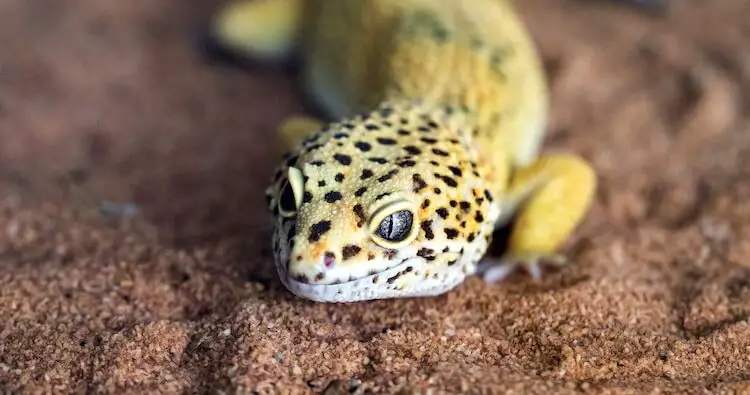
How Long Practise Leopard Geckos Live For?
A captive-bred Gecko or 1 raised in captivity has a long lifespan of 15-20 years.
They are very healthy and mutual diseases such as Metabolic Bone Disease, or medical issues like impaction, tin be prevented by following correct husbandry communication and managing their environs and nutrition.
A happy Leopard Gecko should be active at nighttime and for a pocket-size portion of the day.
If their enclosure is warm plenty, at the correct humidity, and your reptile has no stressors present, they should accept no trouble existence alert during the evening.
Stressed Geckos do non come out of hiding and may:
- Vocalize a hissing audio.
- Moving ridge their tail slowly when approached.
- Drib their tails if driven to extreme fearfulness.
Leopard geckos have autotomy, where they can drop their tails when threatened.
Their tail will regenerate, however, it will never grow back the same, it will differ in shape, texture, and pattern. The process of regeneration is very free energy-consuming and any thinning of their tail indicates affliction.
A ill leopard gecko volition not eat.
Temperature and humidity values outside of their natural range are dangerously fatal:
- If they live in an enclosure with a loftier humidity (over 70%) they tin develop respiratory infections.
- They will become dehydrated if the humidity is likewise low.
- If tank temperatures are too low they will become unable to metabolize and will lose bodily functions.
Finally, be sure to observe your Leopard Gecko's feces. Runny matter indicates illness or a need for a diet change, and endoparasites volition lead to blood in carrion.
Leopard Gecko Habitat and Cage
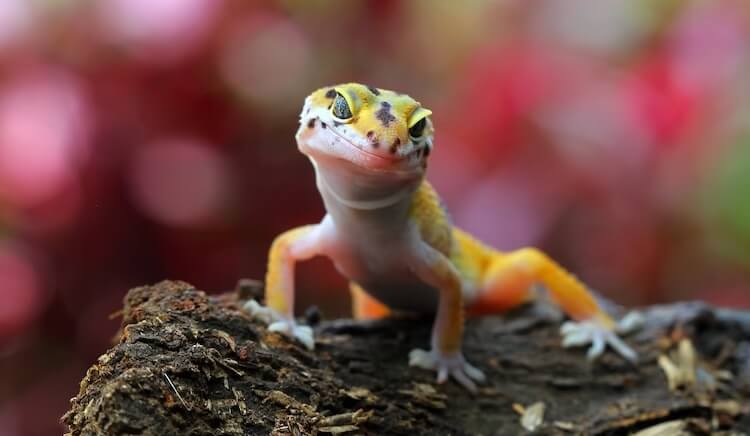
Y'all will demand, at a minimum, a twenty-gallon long vivarium for 1 adult Leopard Gecko.
A wooden or glass vivarium is ideal.
Unlike some lizards that demand unlike sized tanks as they grow. Many owners choose to start their babe and juvenile Geckos in the same 20-gallon tank adults use.
If you are housing 1 male person and two females for breeding, then go for a twoscore-gallon. When housing more than one lizard make sure they have their own hideout area or hide box in the tank.
Each enclosure needs to have three hideouts that are big plenty to fit an adult gecko and enclosed enough to be night and snug inside. Each hideout has a dissimilar purpose and should be either moist, warm, or cool.
Within some hideouts, place kokosnoot cobweb or sphagnum moss in order to create a micro-humidity bedchamber to aid with shedding. Bathing leopard geckos is not necessary if they have soaking bowls and micro-humidity chambers.
Identify the hideouts at varying levels of the cage; somewhere they can climb to and some on the ground floor.
You tin also cull to add branches and rocks in their enclosure and non-toxic pants volition brand the tank expect fantastic.
Lighting and Heating
Their tank needs a basking seedling for the daytime and a ceramic bulb for night.
They demand a heat gradient in the tank with one side that reaches 90°F and the cool side can be around 75°F. Ensure their basking bulb is non also brilliant equally they prefer cool-white lights.
Leopard Geckos are nocturnal and so their lighting must be turned off in the evening for 12 hours of the night.
Night-fourth dimension temperatures can drib to effectually 70°F but shouldn't go much lower. An undertank heating pad is a good solution to regulating temperature if their basking lamp is insufficient.
Because their natural habitat is a desert, humidity should stay in the range of 30-40%.
This can be achieved by having 1 soaking bowl in the enclosure. Make sure the soaking basin is big enough for your cadger to fit in, simply not likewise deep so that the water level comes above their ears.
You should install digital thermometers and humidity gauges to cheque the temperatures of the warm side and absurd side of the tank.
Substrate
Many owners utilise reptile carpet, paper towels, or paper for their Leopard Gecko's substrate. Some prefer bedding such equally aspen shaving, cypress mulch, or kokosnoot cobweb. Whatever of those choices will work as a suitable substrate.
You should avert using sand and calcium sand because it will crusade impaction if swallowed.
If you choose a reptile carpet information technology volition need to be spot-cleaned daily. Each month it will need to either be deep cleaned with bleach or replaced entirely, depending on its level of wear.
Newspaper or newspaper towels will need to be replaced weekly.
Any selection of bedding (east.m. aspen shaving, cypress mulch, or coconut fiber) will need to be spot scooped daily and entirely replaced monthly.
When doing a monthly deep-clean, use water and bleach (i:xxx solution) and allow for the solution to dry out completely and evaporate before returning your lizard or any décor to the enclosure.
Typical Behavior
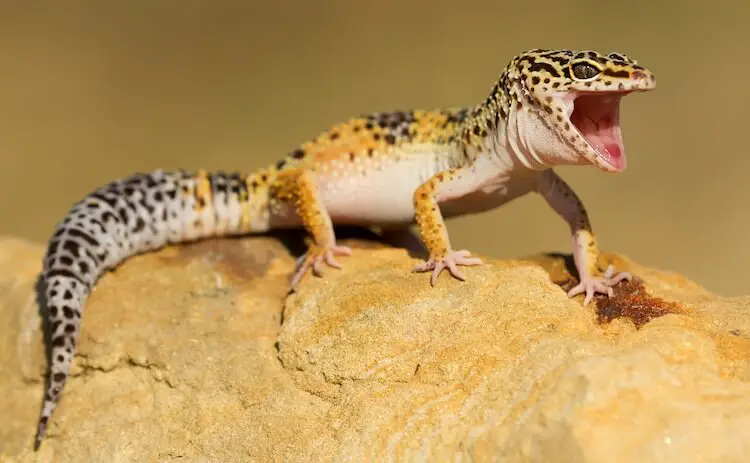
Leopard Geckos are scrubland and grassland reptiles.
Reverse to popular belief, Geckos tend to live in groups with a single male and multiple females. In the wild a single male will protect the females and fight predators.
If you are planning on having more than 1 leopard gecko, ensure that only one is male person. Males become territorial with ane another and will fight. Really, you should only house multiple leopard geckos together if you are are breeding them.
In the wild they spend nigh of their time either climbing or burrowing:
- They use their claws to climb up shrubs, trees, or rocks
- They burrow in soil or rock caves to absorb oestrus and evade predators (larger lizards, snakes, birds of prey, and foxes).
With many predators it is not practical for a Leopard Gecko to bask out in the open (every bit many other ectotherms do). Instead, they find hidden rocks or branches that indirectly transfer the sun's heat.
When nighttime arrives, they come out of their hiding spot to feed.
They are opportunistic hunters so will look for prey to come to them – using their hearing and olfactory senses they can easily strike nearby prey.
This reptile is non picky and will eat most live organisms within their proximity. They are known to consume any insect, some bird eggs, and can even be cannibalistic.
Leopard geckos live in habitats with cooler wintertime temperatures. During the cooler winter temperatures, they cannot regularly metabolize so they get into what'south known every bit brumation (i.e. reptile hibernation).
In captivity, your gecko may or may non engage in brumation.
You can induce brumation for healthy adults by providing less food and lowering their tank'southward temperature.
Nearing December, provide less and less nutrient and lower tank temperatures to room temperature (68 – 77°F). Bring heat support to 85°F in March, and offering food a few days after they wake upward.
Treatment Advice
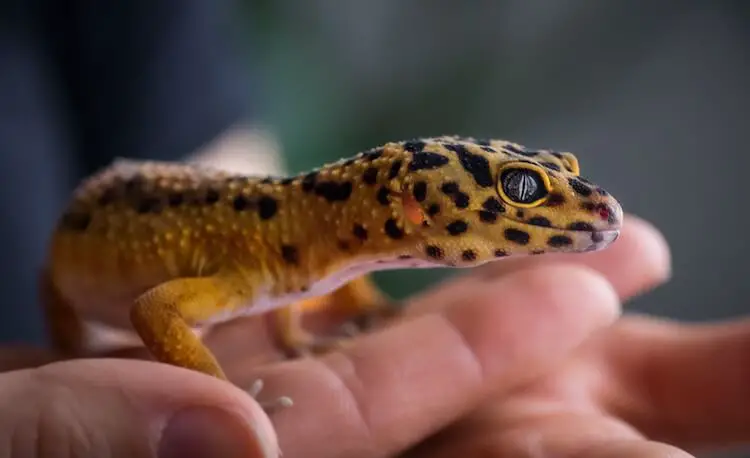
Leopard Geckos savor climbing and exploring.
It is very of import that they have a habitat to climb and explore with branches and rocks. However, they should besides be taken out of their enclosure.
They honey to climb on arms and are known for being a docile reptile then will rarely bite.
Earlier handling, think this species has tail autotomy. Never choice upwardly a leopard gecko by the tail – it volition fall off.
Brand sure to use the tips below when treatment:
- Starting time by placing a flat paw down and ease him onto your palm.
- Hold him with a flat hand, supporting his legs and tail. If he feels insecure, they may emit barking sounds and move their tail.
- Walk slowly with him (don't run or make fast movements).
- Start with pocket-size five-minute treatment sessions.
- Proceed this daily until he is comfortable.
Multiple Leopard Geckos
Most people start with one only yous may afterwards think about getting other geckos.
If you are planning on having more than ane leopard gecko, ensure that only one is male. Males become territorial with one another and will fight. Really, you should simply house multiple leopard geckos together if you are breeding them.
Feeding multiple geckos can nowadays challenges if one is more food-grubby than another.
If you notice dominant behavior during feeding you should provide separate "feeding containers". These can be small and made of plastic and should have a lid with air vents so that insects cannot escape.
Leopard Gecko Babe
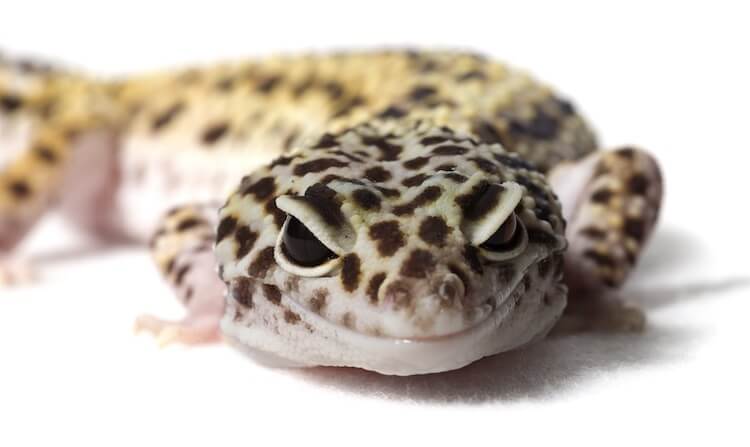
Baby leopard geckos are born with bands on their torso and translucent, smooth skin.
As Geckos mature the bands become detailed patterns of spotting and more vibrant colors announced. They will too form bumps as a scale texture all over their bodies.
Breeding flavor for Leopard Geckos tin be anywhere from Jan to September only it requires the correct temperature.
You can showtime the breeding process past cooling downwardly their surround to 72-75°F (65°F at night) 8 weeks prior to convenance.
Females reach sexual maturity at fifty grams and males at eighteen months.
You tin can make up one's mind the sex activity of a leopard gecko equally early equally ane calendar month by looking at the base of their tail. Males will accept evident hemipenal bulges or bumps that create a V-shaped row and pre-vent pits by the archway of the vent.
A gravid female volition have two bulges past the abdomen.
During pregnancy they need a higher intake of nutrient and enjoy moist micro-humidity chambers with moss and vermiculite.
Developed females will produce iv-5 clutches per flavour each with two eggs. One time laid, carefully movement the eggs into incubators without irresolute t he eggs' orientation.
Selective Convenance
Incubation temperature volition determine the sex of hatchlings :
- 80-82°F will produce all females
- 85°F will be equally dissever
- 89-90°F will be all male
How Much Does A Leopard Gecko Cost?
Common leopard geckos sell for $50. Nonetheless, some morphs are significantly more expensive at $400 considering of their unique appearance.
Any Gecko y'all purchase brand sure information technology is from a reputable breeder and looks healthy.
| Leopard Gecko Facts | |
|---|---|
| Common Names | Panther, Desert Fat-Tailed and Spotted Fat-Tailed Geckos |
| Scientific Name | Eublepharis macularius |
| Toll | $50-$400 |
| Size | 6.5 – ten inches (males are larger) |
| Weight | 40 – 100 grams (males are larger) |
| Lifespan | 15 – twenty years |
| Nutrition | Crickets, Mealworms, Waxworms, Locusts and Pinkie mice |
| Tank Size | Minimum 10-gallon |
| Humidity & Temperature | Temperature: lxx – 85°F Humidity: 30 – forty% |
| Popular Alternatives | African fat-tailed Gecko or Gargoyle Gecko |
Care Guide Summary
Leopard Geckos are a fantastic pet option for kickoff-time owners because of their docile and playful nature.
They are very beautiful lizards with their famous leopard-like advent and lips that shape the perfect smile when they look up at y'all.
Maintenance and husbandry are very simple with easy nutrition and cleaning requirements. As long as you are gentle and feed them correctly they will gladly bound into your palms!
They have many special qualities that y'all will discover subsequently adopting!
Practice yous take a Leopard Gecko at habitation? Permit us know how life is with one below.
Source: https://www.everythingreptiles.com/leopard-gecko/
0 Response to "Leopard Gecko Toes Grow Back Leopard Gecko Baby Substrate"
Post a Comment